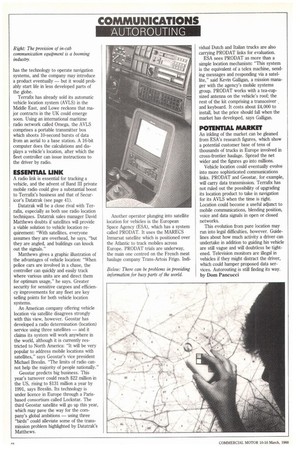COMMUNICATIONS AUTOROUTI\G
Page 58

If you've noticed an error in this article please click here to report it so we can fix it.
has the technology to operate navigation systems, and the company may introduce a product eventually — but it would probably start life in less developed parts of the globe.
Terrafix has already sold its automatic vehicle location system (AVLS) in the Middle East, and Lowe reckons that major contracts in the UK could emerge soon. Using an international maritime radio network called Omega, the AVLS comprises a portable transmitter box which shoots 10-second bursts of data from an aerial to a base station. A 16-bit computer does the calculations and displays a vehicle's location, after which the fleet controller can issue instructions to the driver by radio.
A radio link is essential for tracking a vehicle, and the advent of Band III private mobile radio could give a substantial boost to Terrafix's business and that of Securicor's Datatrak (see page 41).
Datatrak will be a close rival with Terrafix, especially as both use radio location techniques. Datatrak sales manager David Matthews doubts if satellites will provide a viable solution to vehicle location requirement: "With satellites, everyone assumes they are overhead, he says, "but they are angled, and buildings can knock out the signals."
Matthews gives a graphic illustration of the advantages of vehicle location: "When police cars are involved in a chase, the controller can quickly and easily track where various units are and direct them for optimum usage," he says. Greater security for sensitive cargoes and efficiency improvements for any fleet are key selling points for both vehicle location systems.
An American company offering vehicle location via satellite disagrees strongly with this view, however. Geostar has developed a radio determination (location) service using three satellites — and it claims its system will work anywhere in the world, although it is currently restricted to North America: "It will be very popular to address mobile locations with satellites," says Geostar's vice president Michael Breslin. "The limits of radio cannot help the majority of people nationally."
Geostar predicts big business. This year's turnover could reach $22 million in the US, rising to $131 million a year by 1991, says Breslin. Its technology is under licence in Europe through a Parisbased consortium called Lockstar. The third Geostar satellite will go up this year, which may pave the way for the company's global ambitions — using three "birds" could alleviate some of the transmission problem highlighted by Datatrak's Matthews. Another operator plunging into satellite location for vehicles is the European Space Agency (ESA), which has a system called PRODAT. It uses the MARECS Inmarsat satellite which is positioned over the Atlantic to track mobiles across Europe. PRODAT trials are underway, the main one centred on the French meat haulage company Trans-Artois Frigo. Indi vidual Dutch and Italian trucks are also carrying PRODAT links for evaluation.
ESA sees PRODAT as more than a simple location mechanism: "This system is the equivalent of a telex machine, sending messages and responding via a satellite," said Kevin Galligan, a mission manager with the agency's mobile systems group. PRODAT works with a tea-cupsized antenna on the vehicle's roof; the rest of the kit comprising a transceiver and keyboard. It costs about 24,000 to install, but the price should fall when the market has developed, says Galligan.
An inkling of the market can be gleaned from ESA's research figures, which show a potential customer base of tens of thousands of trucks in Europe involved in cross-frontier haulage. Spread the net wider and the figures go into millions.
Vehicle location could eventually evolve into more sophisticated communications links. PRODAT and Geostar, for example, will carry data transmission. Terrafix has not ruled out the possibility of upgrading its location product to take in navigation for its AVLS when the time is right. Location could become a useful adjunct to mobile communications, blending position, voice and data signals in open or closed networks.
This evolution from pure location may run into legal difficulties, however. Guidelines about how much activity a driver can undertake in addition to guiding his vehicle are still vague and will doubtless be tightened. Television monitors are illegal in vehicles if they might distract the driver, which could hamper proposed data services. Autorouting is still finding its way. by Dom Pancucci








































































































